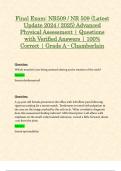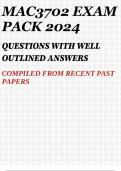Final Exam: NR509 / NR 509 (Latest
Update ) Advanced
Physical Assessment | Questions
with Verified Answers | 100%
Correct | Grade A - Chamberlain
Question:
Which muscle(s) are being assessed during active rotation of the neck?
Answer:
Sternocleidomastoid
Question:
A 34-year-old female presents to the office with left elbow pain following
rigorous training for a tennis match. Tenderness is noted with palpation in
the area on the image marked by the red circle. What correlative diagnosis
does this assessment finding indicate? ADA Description: Left elbow with
emphasis on the small, tuberculated eminence, curved a little forward, about
1 cm from the joint.
Answer:
lateral epicondylitis
,Question:
A 35-year-old male presents to the clinic for a routine physical examination.
His only complaint is a feeling of heaviness in his scrotum. He denies injury or
trauma. After conducting a history and physical, the NP documents the
following genitourinary (GU) findings: Uncircumcised penis; prepuce easily
retractable. No penile discharge or lesions. No scrotal swelling or
discoloration. Testes descended bilaterally; right testicle smooth; 1 × 1 cm
firm, fixed, nontender, nodule on the left lateral testicle. Epididymis
nontender. No inguinal or femoral hernias. Negative CVA tenderness. Which
of the following is the most accurate interpretation of these findings?
Answer:
These findings suggest testicular cancer
Question:
A 26-year-old female presents to the Emergency Department with intense
abdominal pain for 6 hours, light-headedness, and a fainting episode that
finally prompted her to seek medical attention. She has a history of gallstones
and is concerned that she is having another gallbladder attack. She denies
nausea and vomiting, and her last normal bowel movement was this morning.
She reports that her LMP was 10 weeks ago. Vital signs: pulse 118; blood
pressure, 86/68; respiratory rate, 20/min; oxygen saturation, 99%; and
temperature, 37.3ºC orally. A β-human chorionic gonadotropin (β-hCG) blood
test is pending. The NP performs an abdominal exam prior to her pelvic exam
and, on palpation of her abdomen, finds involuntary rigidity and rebound
tenderness. Which of the following is the most likely etiology for these
assessment findings?
Answer:
Ruptured ectopic pregnancy
,Question:
A 42-year-old female presents to the office for her annual well-woman
examination. She has a history of fibrocystic breast changes since her mid-
20s, so she did not report any new issues except that her right breast feels
"heavier" than usual. After a careful history and physical examination, the NP
documents the following breast findings: Breasts pendulous with diffuse
fibrocystic changes. Single firm 1 × 1 cm mass, mobile, and nontender, with
overlying peau d'orange appearance in the right breast, upper outer quadrant
at 11 o'clock, 2 cm from the nipple. Which of the following is the most
accurate interpretation of these findings?
Answer:
These findings suggest a cyst
Question:
An NP student conducted a clinical breast examination on a 27-year-old
female with a history of fibroadenomas. The NP palpated a rubbery, mobile,
nontender mass in the right breast. The mass was located 3 cm proximal to
and 3 cm to the left of the nipple. Which of the following would be the most
appropriate way to document the physical assessment findings?
Answer:
rubbery, mobile, nontender mass located in the right breast, in the 10:30
position from the nipple
, Question:
A 24-year-old male presents to the office for evaluation of a lump under his
left nipple. He reports no other symptoms, denies trauma or injury, and
reports no known family history of a first-degree relative with breast cancer.
On examination, the NP notes a firm, 2-cm mass under his areola. What is
the most likely etiology for these findings?
Answer:
Breast cancer
Question:
A 34-year-old female arrives at the clinic for a prenatal, second-trimester
appointment. During the interview, her behavior is concerning for
intoxication, and she smells of alcohol and cigarettes. She reveals a history of
intravenous drug use "10-years ago". How should the NP counsel this patient?
Select all that apply
Answer:
If a pregnant patient does not intend to quit tobacco, cutting down is still
considered beneficial to the pregnancy and should be encouraged.
Pregnant women are not routinely screened for hepatitis C, but this test
should be added to the panel of prenatal blood tests for patients with a
history of intravenous drug use





